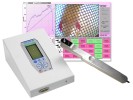Authors
del Valle, J., de la Oliva, N., Muller, M., Stieglitz, T. et al.
Lab
Dept. of Cell Biol., Physiol. & Immunology, Univ. Autonoma de Barcelona, Bellaterra, Spain
Journal
Neural Engineering (NER)
Abstract
For assessing the suitability of a given material for peripheral nerve implantation, acute and chronic tests to investigate tissue reaction, and evaluate the thickness of fibroblast layers that surround the material and the presence of inflammatory cells are mandatory. In this study we compared in vivo the biocompatibility of parylene C and polyimide, two materials intended for fabrication of neural electrodes. We have tested these two materials after implantation of thin devices in the peripheral nerve of rats, by functional and morphological methods, assessing thickness of the fibrotic capsule, signs of inflammation and axon survival in areas close to the implant. Intraneural implantation of parylene C and polyimide devices did not produce any functional alteration in the sciatic nerve, as evidenced by electrophysiological, locomotion and nociceptive functional tests. The intraneural devices were encapsulated within a fibroblastic tissue. Resolution of the inflammatory infiltrate took 4-8 weeks. In conclusion, both parylene and polyimide electrodes show biocompatible characteristics and induce a similar fibrotic reaction after chronic intraneural implantation.
BIOSEB Instruments Used:
Electronic Von Frey 4 (BIO-EVF4),Electronic Von Frey 5 with embedded camera (BIO-EVF5)

 Douleur - Allodynie/Hyperalgésie Thermique
Douleur - Allodynie/Hyperalgésie Thermique Douleur - Spontanée - Déficit de Posture
Douleur - Spontanée - Déficit de Posture Douleur - Allodynie/Hyperalgésie Mécanique
Douleur - Allodynie/Hyperalgésie Mécanique Apprentissage/Mémoire - Attention - Addiction
Apprentissage/Mémoire - Attention - Addiction Physiologie & Recherche Respiratoire
Physiologie & Recherche Respiratoire
 Douleur
Douleur Système Nerveux Central (SNC)
Système Nerveux Central (SNC)  Neurodégénérescence
Neurodégénérescence Système sensoriel
Système sensoriel Système moteur
Système moteur Troubles de l'humeur
Troubles de l'humeur Autres pathologies
Autres pathologies Système musculaire
Système musculaire Articulations
Articulations Métabolisme
Métabolisme Thématiques transversales
Thématiques transversales SFN2024: Venez rencontrer notre équipe sur le stand 876 à Chicago
SFN2024: Venez rencontrer notre équipe sur le stand 876 à Chicago 
